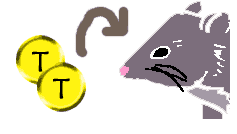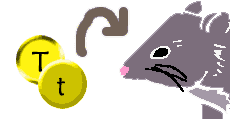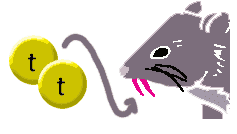Onwards to genetics
So, lets talk about genetics. Specifically, alleles, genotypes, and phenotypes. The allele I had in mind is a recessive allele called vam37 that causes housemice to develop vampire-like fangs (just try to prove that this doesn't exist).
First, let's define some terms. I'm sure your book has longer definitions (yes, I looked) but this is pretty much what you need to know mathematically speaking.
Allele: An allele is a SINGLE copy of the gene causing a particular effect. In our case, there are two forms of the allele: one causes regular teeth, the other causes vampire fangs. In diploid organisms, alleles normally come in pairs -- one inherited from the mother, and one from the father. Together the two alleles make a whole, like Siamese twins, or yin yang symbols, or … two sides of one coin.
 |
 |
 |
Genotype: When you put two sides of a coin together, you get money. When you put two alleles together, you get …. a genotype. A coin usually has a heads and a tails, but it could have heads on each side or tails on each side. Likewise, the alleles in the genotype may or may not have the same form. In our example, both alleles will relate to teeth, but there could be any combination of regular teeth and vampire fangs. So, the GENOTYPE literally tells you what TYPE of GENES are in the pair. It could be two vampire fang alleles. It could be two regular mouse-teeth alleles. It could be one of each. Each of these three possibilities is a genotype.
Phenotype: My analogy is going to break down a little here. Genotype needs to get translated into phenotype (physical reality) somehow. Clearly if the genotype is 2 regular teeth alleles, the mouse will have the ‘regular teeth' phenotype, no need for orthodontia. And, if the genotype has 2 vampire alleles, then the mouse can go around scaring virgins at night and sleeping by day (‘vampire teeth' phenotype). But what if the unfortunate mouse has a genotype with one of each allele? Clearly a mouse with half-length vampire teeth would be dysfunctional. And a mouse with vampire teeth only on one side would be a laughingstock. No, either mice are vampires or they're not, which leads us to…
 |
 |
 |
|---|
Dominant and Recessive: Since we can't have a half-normal, half-vampire mouse, one of the alleles will just have to dominate over the other. The dominating allele is called dominant, while the non-dominating one is called recessive, as in, it recedes into the background. It doesn't go away (this is important!), but it just … recedes, stands there observing, fidgeting, possibly making nasty but inaudible comments, and generally waiting for its chance for revenge (more about that soon). *For the sake of completeness, I note that some alleles are not dominant or recessive, but additive – their effects add. If this was the case, then one copy of vam37 would give you vampire teeth and the second copy would make the teeth extra long.
Copyright University of Maryland, 2007
You may link to this site for educational purposes.
Please do not copy without permission
requests/questions/feedback email: mathbench@umd.edu